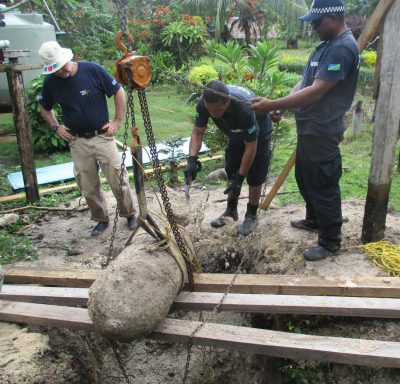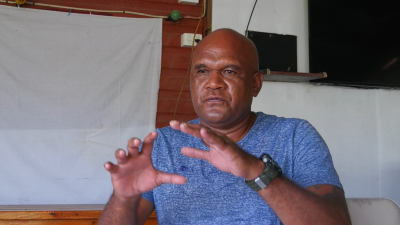Police go as far as US to verify pipe that explode and killed two people
The Royal Solomon Islands Police Force (RSIPF) Explosive Ordnance Disposal (EOD) Unit is continuing their investigation and have gone as far as the United States of America (USA) to confirm the origin of the pipe that exploded and killed two people last week.
RSIPF EOD Officer In-charge (OIC) Inspector Clifford Tunuki said until they complete their investigations, there is no point of speculating.
But he said: “It may have been an improvised device manufactured as far back during the Second World War (WWII).”
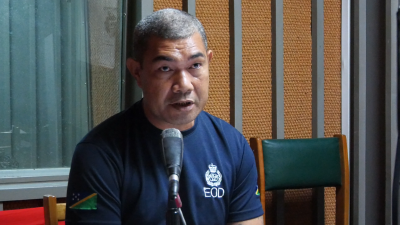
RSIPF EOD Officer In-charge (OIC) Inspector Clifford Tunuki speaking during the Police Radio Program this week. Photo: Jared Koli
Mr Tunuki said given the amount of battles that were fought in Guadalcanal and the greater Solomon Islands during WWII, there are a lot of Unexploded Ordnance (UXO) and raw explosives lying around.
He said it is likely that the pipe that exploded was a WWII relic and probably filled with explosives.
“It is possible that it is a type of demolition charge referred to as a Bangalore Torpedo, although none of the measurements taken from US and Japanese technical manuals match this particular item.
“At this stage we are not confirming anything yet, we are still investigating,” Mr Tunuki said.
The fatal explosion occurred at Upper Betikama on the outskirts of east Honiara around 7pm on Monday last week and killed a father and his nine-year old son, a grade five student.
The EOD OIC said the item that exploded was not a munition they normally locate but it may have been an abandoned demolition charge (which is what a Bangalore torpedo is).
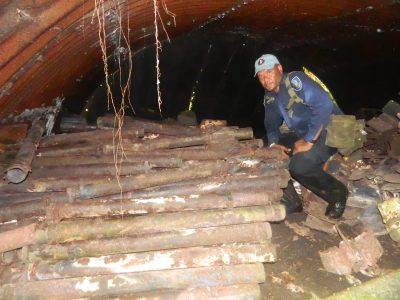
Michael Maka, a former EOD Supervisor stands beside a pile of unexploded Bangalore Torpedo when he led a team to Bougainville in 2014. Photo Supplied/Michael Maka
“Until we have completed our investigations there is no point in speculating,” Tunuki said.
He said the investigation is ongoing and it will take time.
He advises all Solomon Islanders to be vigilant and to inspect everything they own that looks like it may have come from WWII.
“This could be old pipes, old tins that could have contained ammunition and even empty brass casings.
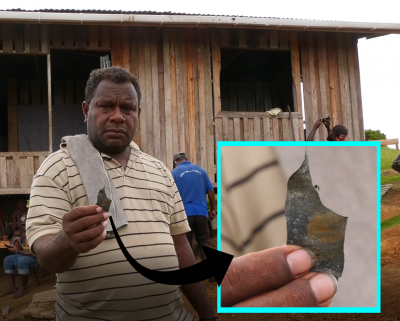
A witness at the recent blast site on the outskirts of Betikama with a piece of metal from the blast. Photo: Jared Koli
“If you don’t know what something is and it may look as if it is from WWII then it may contain dangerous material or even be part of a bomb.
“If you inspect an item and believe it contains something suspicious then you need to put it somewhere safe and contact RSIPF on their emergency number, 999.
Tunuki strongly warns the public not to place unfamiliar objects close to the fire.
“If you are going to start a fire on the ground, especially if it is for the first time in that location, carefully dig around and make sure there is nothing suspicious under the ground,” he said.
Meanwhile, Michael Maka, a former Police UXO operator who has served the EOD team for 15 years, five years on supervisory role, and trained internationally said Guadalcanal and wider Solomon Islands has a lot of unexploded ordnance.
He said the whole of Guadalcanal Island was a battlefield during WWII from 1942 to 1943. He said apart from Guadalcanal, Western Province, Central Islands, Isabel, Malaita, Makira and even Renbell provinces have UXO.
Maka told SIBC News that after assessing the fatal blast last week, he was certain that the metal that exploded was a Bangalore torpedo.
This was because according to an inside confidential report he accessed, which was also leaked to SIBC News, stated similarities in the characteristics and measurement of the alleged UXO that exploded.
Four people have died from unexpected UXO explosions in locations within and close to the capital Honiara, two last year and two this year.
Honiara was built on a major battle ground that marked the turning point in the Pacific war fought between the US Allied Forces and Japan during the Second World, a grim legacy from almost 80 years ago.
In September last year, an Australian and a British bomb disposal workers were killed in an explosion at their home at Tasahe in west Honiara.
Less than six months later, two locals were also killed in May. The two all succumbed to a WW2 US 105mm high explosive projectile that detonated and also injured two others in Lengakiki, Honiara.
The two that died last week would be the latest victims if the Police investigation concluded that the cause of the blast was from a WWII UXO.
Dr Claude Posala, a cousin of one of the two that died in May, told ABC News that Solomon Islands’ government won’t be able to clean up the UXOs.
“We don’t have the capacity.”
He said the US government had a “moral obligation” to remove these dangerous weapons from Solomon Islands.
“US, this is your mess,” he said as quoted from ABC News.
Meanwhile, the local UXO expert and consultant, Mr Maka said the UXOs will still remain in the Solomon Islands for generations to come.
He said during his time with EOD, they collected more than 3000 different types of UXOs in Guadalcanal alone in one year.
“We can only remove and detonate those that can be detected by UXO sensors, but there are many still out there in the seafloor and buried underground.
“From now up to four generations after me, this country will still have UXOs both inland and in the sea,” he said.
by Jared Koli


